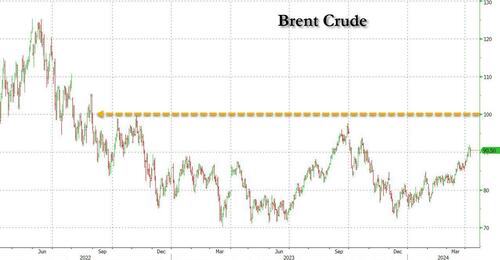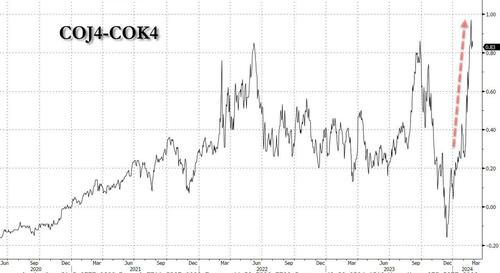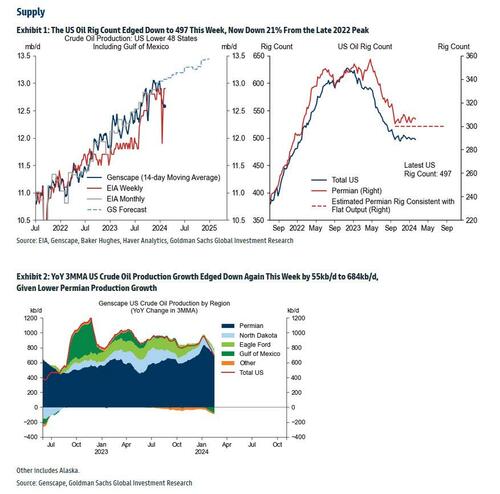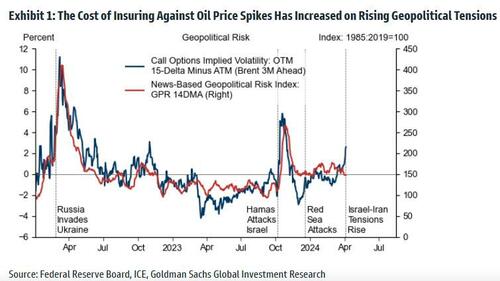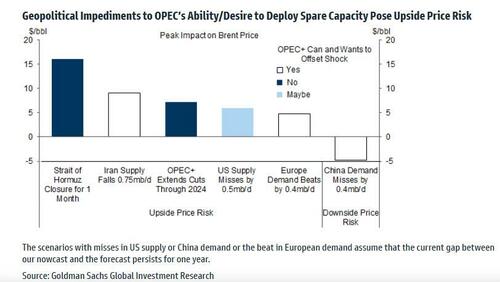
Back in early December, just after Powell's dovish pivot shocked everyone, many closet oil bulls like BofA's energy strategist Francisco Blanch, predicted that a dovish Fed would send oil back to $100. Unfortunately for him, oil did nothing and just one month later, as no oil buying had materialized, Blanch threw in the bullish towel and cut his oil price forecast by 11%, ironically bottom ticking to the dot oil just as it was about to soar by 20% in the next three months, an ascent which was capped with... Blanch raising his Brent oil price forecast.
To be sure, BofA wasn't the only one to predict $100 oil: two weeks ago JPMorgan commodity analyst Natasha Kaneva was looking at Russia's unexpected pivot to producing less oil than it was allowed, and wrote that "the shift in Russia’s oil strategy is surprising" and "at face value, and assuming no policy, supply or demand response, Russia’s actions could push Brent oil price to $90 already in April, reach mid-$90 by May and close to $100 by September, keeping pressure on the US administration in the run-up to elections."
In short, the fate of Biden's re-election was now in the hands of Putin if the Russian leader wanted to push up the price of oil back to triple digits by limiting output, and the only recourse Biden has - according to JPMorgan - was releasing another 60 million barrels of oil from the SPR (see full JPM note here).
But it increasingly appears that $100+ oil is inevitable, regardless of what Putin does or does not do, and as Bloomberg writes over the weekend, the odds of $100 oil are rapidly rising, because while the recent surge in po; above $90 just days ago was blamed on escalating military tensions between Israel and Iran, "the rally’s foundations went deeper — to global supply shocks that are intensifying fears of a commodity-driven inflation resurgence."
Consider: a recent move by Mexico to slash its crude exports is compounding a global squeeze, prompting refiners in the US (the world’s biggest oil producer) to consume more domestic barrels. At the same time, American sanctions have stranded Russian cargoes at sea, with Venezuelan supply a potential next target. Meanwhile, Houthi rebel attacks on tankers in the Red Sea have delayed crude shipments, and despite all the "turmoil", OPEC and its allies are sticking with their production cuts.
It all adds up to a magnitude of supply disruption that has taken traders by surprise. The crunch is turbocharging an oil rally ahead of the US summer driving season, threatening to push Brent crude, the global benchmark, to $100 for the first time in almost two years; in fact the last time oil was trading there, Joe Biden was draining the SPR to the tune of several million barrels per week. That’s amplifying the inflation concerns that are clouding US President Joe Biden’s reelection chances and complicating central banks’ rate-cut deliberations.
For oil, “the bigger driver right now is on the supply side,” said Amrita Sen, founder and director of research at Energy Aspects. “You have seen quite a few pockets of supply weakness, and demand overall on a global basis is healthy.”
According to Bloomberg, oil shipments from Mexico, a major supplier in the Americas, slid 35% last month to their lowest since 2019 as President Andres Manuel Lopez Obrador tries to make good on promises to wean the country off costly fuel imports. The country’s exports of so-called sour crude — the heavy, dense kind that many refineries are designed to process — now stand to shrink even further as state-controlled oil company Pemex is now planning on cutting an additional 330 kb/d in May, Reuters reported citing sources.
That decision has roiled oil markets around the world. Mars Blend, a medium-density sour crude from the US Gulf Coast, has in recent days risen to a multi-year premium over lighter WTI, the national benchmark. Mars usually trades at a discount to WTI. Brent crude hit $90 a barrel on Thursday, the highest since October, and extended gains on Friday. JPMorgan said it could hit $100 by August or September.
Canadian Cold Lake oil priced at the Gulf Coast traded at the narrowest discount to WTI in almost a year. Key indicators for Middle Eastern medium-sour crude, such as Oman and Dubai contracts, are rallying too.
To be sure, it's not just Mexico's fault: back in February we first warned that long before hedge funds - all heavily short crude - realized what was coming, the physical market was screaming tightness with the Brent prompt spread exploding to a backwardation around 90 cents after tumbling to a multi-year low in late December.
And indeed, a closer look at oil supply showed that there was a clear drop off in production which would guarantee higher prices.
The sharp drop in output in early 2024 came before Mexico’s move, when we noted a sequence of supply disruptions both large and small: in January, a deep freeze ate away at crude output and inventories in the US at a time when they would normally grow, keeping stockpiles below seasonal averages through late March. Then, Mexico, the US, Qatar and Iraq cut their combined oil flows by more than 1 million barrels a day in March, tanker tracking data showed (Baghdad pledged to limit output to make up for non-compliance with prior pledges to OPEC+).
Also adding to the tightness, OPEC member the United Arab Emirates curbed shipments of its Upper Zakum, a medium-sour oil, by 41% in March compared with last year’s average, according to Kpler data. The state oil company is diverting more supplies of that crude to its own refinery, traders told Bloomberg. Though the cuts were expected and Abu Dhabi National Oil Co. is offering buyers another type of crude as a substitute, the decline in Upper Zakum exports is contributing to higher regional prices amid the broader OPEC+ curtailment.
Crude markets in Europe, meanwhile, were pressured higher by the Houthi attacks in the Red Sea, which sent millions of barrels of crude on a detour around Africa, delaying some supplies for weeks. Disruptions to a key North Sea pipeline, unrest in Libya and a damaged pipe in South Sudan also contributed to the rally, while US sanctions have deprived Russia of tankers that previously transported its oil to buyers including India.
Making matters worse for Biden who is absolutely terrified of higher oil and gas prices, the supply pinch could become even more acute in the weeks ahead. That's because Venezuela dictator Nicolas Maduro is showing no sign of heeding promises he made to Biden and other "democracies" to move toward free and fair elections, in response the Biden administration could reimpose sanctions this month, although it most likely won't as it would mean an even lower approval rating for the outgoing US president, confirming once again just how malleable and laughable western "democratic" ideals are.
The plunge in supply - which we warned about two months ago, and which has materialized now - is a stark contrast from just a few months ago, when oil plunged to multi-month lows as US production climbed and Russian seaborne crude exports ratcheted higher despite sanctions, which have since been expanded. The US Energy Information Administration, after forecasting global inventories to remain unchanged this quarter, now predicts they’ll fall by 900,000 barrels a day. That’s the equivalent to the production from Oman.
Putting it all together, Goldman - which has turned decidedly less bullish on oil ever since the firm's iconic commodity analyst Jeff Currie quit last year - last night published a report (available to pro subscribers) in which it said that the market is finally pricing in "firm demand and geopolitical supply risks, which together have boosted positioning and valuation."
And while Goldman expects Brent to stay below $100/bbl in its base case in which the bank assumes:
- already solid demand,
- no additional geopolitical supply hit, and
- that elevated spare capacity will lead OPEC+ to raise production in Q3.
... the bank warns that "geopolitical impediments to OPEC’s ability/desire to deploy spare capacity could send Brent above $100." Needless to say, when it comes to "base case" forecasts from Goldman's research desk (not to be confused with the bank's terrific Sales and Trading desk), they virtually always end up being wrong, which is why $100 oil is now virtually guaranteed.
Goldman also listed other reasons why Brent could reach $100, including i) the Russia-Ukraine or Middle East conflicts may damage upstream, midstream, or downstream oil infrastructure, and ii) Iranian oil supply may decline on disruptions or under a potentially more hawkish US.
Below we excerpt from the Q&A attached to the Goldman report (the full note is available to pro subs in the usual place).
Q. Why have crude oil prices rallied?
Brent has rallied to $91/bbl because the market is now pricing in a firmer demand outlook and some geopolitical downside risks to oil supply, which together have boosted positioning and valuation.
Upgraded market expectations of oil demand have fueled the rally.
- First, the IEA forecast of 2024 oil demand growth has crept higher on solid oil demand data outside China, and GDP upgrades.
- Second, sentiment about demand in investor conversations has turned from bearish to constructive.
- Third, oil prices have also risen after strong activity releases this week, including manufacturing surveys in China, the US, and India and US employment.
The geopolitical risk premium—the compensation investors demand for the risk that geopolitical shocks reduce oil supply—has also picked up following attacks on Russian refineries, and rising Iran-Israel tensions. That said, the cost of insuring against oil price spikes remains less elevated than in October 2023 and in 2022, because Middle East crude production remains unaffected by the war (Exhibit 1).
As the market is now pricing in firm demand and geopolitical supply risks and as oil demand for inflation hedging has picked up, measures of positioning and valuation have risen sharply. Net managed money in crude and refined products has surged by over 400 million barrels since December (Exhibit 2). Our pricing framework suggests that actual Brent 1/36m timespreads have shifted from significantly undervalued in December to now modestly overvalued based on our nowcast of OECD inventories and our assumption of a modest 0.4mb/d Q2 deficit.
And the punchline: Q. What could push Brent oil prices above $100/bbl?
We see only modestly bullish risks to our non-OPEC+ balance from firmer demand in Europe, and likely temporary softness in US supply. In contrast, we believe that lower OPEC supply for longer, for instance because of geopolitical impediments to OPEC’s ability and/or desire to deploy spare capacity, could send Brent above $100 for some time.
Specifically, we see upside risks to our 2023Q3 Brent forecast of $86/bbl in several potential geopolitical scenarios:
- OPEC+ may extend the existing production cuts further in a context of increased tensions between the West and several key OPEC+ countries
- The Russia-Ukraine or Middle East conflicts may damage upstream, midstream, or downstream oil infrastructure (as has happened to Russian refineries)
- Iranian oil supply may decline on disruptions or under a potentially more hawkish US Administration
- While highly unlikely, we estimate that an interruption of oil flows through the Strait of Hormuz would lead oil prices to rise 20% in the first month and eventually double if the interruption persisted for several months
Translation: not just Putin, but all of OPEC+ now controls the outcome of the 2024 US election.
More in the full note available to pro subscribers.
Back in early December, just after Powell’s dovish pivot shocked everyone, many closet oil bulls like BofA’s energy strategist Francisco Blanch, predicted that a dovish Fed would send oil back to $100. Unfortunately for him, oil did nothing and just one month later, as no oil buying had materialized, Blanch threw in the bullish towel and cut his oil price forecast by 11%, ironically bottom ticking to the dot oil just as it was about to soar by 20% in the next three months, an ascent which was capped with… Blanch raising his Brent oil price forecast.
To be sure, BofA wasn’t the only one to predict $100 oil: two weeks ago JPMorgan commodity analyst Natasha Kaneva was looking at Russia’s unexpected pivot to producing less oil than it was allowed, and wrote that “the shift in Russia’s oil strategy is surprising” and “at face value, and assuming no policy, supply or demand response, Russia’s actions could push Brent oil price to $90 already in April, reach mid-$90 by May and close to $100 by September, keeping pressure on the US administration in the run-up to elections.“
In short, the fate of Biden’s re-election was now in the hands of Putin if the Russian leader wanted to push up the price of oil back to triple digits by limiting output, and the only recourse Biden has – according to JPMorgan – was releasing another 60 million barrels of oil from the SPR (see full JPM note here).
But it increasingly appears that $100+ oil is inevitable, regardless of what Putin does or does not do, and as Bloomberg writes over the weekend, the odds of $100 oil are rapidly rising, because while the recent surge in po; above $90 just days ago was blamed on escalating military tensions between Israel and Iran, “the rally’s foundations went deeper — to global supply shocks that are intensifying fears of a commodity-driven inflation resurgence.”
Consider: a recent move by Mexico to slash its crude exports is compounding a global squeeze, prompting refiners in the US (the world’s biggest oil producer) to consume more domestic barrels. At the same time, American sanctions have stranded Russian cargoes at sea, with Venezuelan supply a potential next target. Meanwhile, Houthi rebel attacks on tankers in the Red Sea have delayed crude shipments, and despite all the “turmoil”, OPEC and its allies are sticking with their production cuts.
It all adds up to a magnitude of supply disruption that has taken traders by surprise. The crunch is turbocharging an oil rally ahead of the US summer driving season, threatening to push Brent crude, the global benchmark, to $100 for the first time in almost two years; in fact the last time oil was trading there, Joe Biden was draining the SPR to the tune of several million barrels per week. That’s amplifying the inflation concerns that are clouding US President Joe Biden’s reelection chances and complicating central banks’ rate-cut deliberations.
For oil, “the bigger driver right now is on the supply side,” said Amrita Sen, founder and director of research at Energy Aspects. “You have seen quite a few pockets of supply weakness, and demand overall on a global basis is healthy.”
According to Bloomberg, oil shipments from Mexico, a major supplier in the Americas, slid 35% last month to their lowest since 2019 as President Andres Manuel Lopez Obrador tries to make good on promises to wean the country off costly fuel imports. The country’s exports of so-called sour crude — the heavy, dense kind that many refineries are designed to process — now stand to shrink even further as state-controlled oil company Pemex is now planning on cutting an additional 330 kb/d in May, Reuters reported citing sources.
That decision has roiled oil markets around the world. Mars Blend, a medium-density sour crude from the US Gulf Coast, has in recent days risen to a multi-year premium over lighter WTI, the national benchmark. Mars usually trades at a discount to WTI. Brent crude hit $90 a barrel on Thursday, the highest since October, and extended gains on Friday. JPMorgan said it could hit $100 by August or September.
Canadian Cold Lake oil priced at the Gulf Coast traded at the narrowest discount to WTI in almost a year. Key indicators for Middle Eastern medium-sour crude, such as Oman and Dubai contracts, are rallying too.
To be sure, it’s not just Mexico’s fault: back in February we first warned that long before hedge funds – all heavily short crude – realized what was coming, the physical market was screaming tightness with the Brent prompt spread exploding to a backwardation around 90 cents after tumbling to a multi-year low in late December.
And indeed, a closer look at oil supply showed that there was a clear drop off in production which would guarantee higher prices.
The sharp drop in output in early 2024 came before Mexico’s move, when we noted a sequence of supply disruptions both large and small: in January, a deep freeze ate away at crude output and inventories in the US at a time when they would normally grow, keeping stockpiles below seasonal averages through late March. Then, Mexico, the US, Qatar and Iraq cut their combined oil flows by more than 1 million barrels a day in March, tanker tracking data showed (Baghdad pledged to limit output to make up for non-compliance with prior pledges to OPEC+).
Also adding to the tightness, OPEC member the United Arab Emirates curbed shipments of its Upper Zakum, a medium-sour oil, by 41% in March compared with last year’s average, according to Kpler data. The state oil company is diverting more supplies of that crude to its own refinery, traders told Bloomberg. Though the cuts were expected and Abu Dhabi National Oil Co. is offering buyers another type of crude as a substitute, the decline in Upper Zakum exports is contributing to higher regional prices amid the broader OPEC+ curtailment.
Crude markets in Europe, meanwhile, were pressured higher by the Houthi attacks in the Red Sea, which sent millions of barrels of crude on a detour around Africa, delaying some supplies for weeks. Disruptions to a key North Sea pipeline, unrest in Libya and a damaged pipe in South Sudan also contributed to the rally, while US sanctions have deprived Russia of tankers that previously transported its oil to buyers including India.
Making matters worse for Biden who is absolutely terrified of higher oil and gas prices, the supply pinch could become even more acute in the weeks ahead. That’s because Venezuela dictator Nicolas Maduro is showing no sign of heeding promises he made to Biden and other “democracies” to move toward free and fair elections, in response the Biden administration could reimpose sanctions this month, although it most likely won’t as it would mean an even lower approval rating for the outgoing US president, confirming once again just how malleable and laughable western “democratic” ideals are.
The plunge in supply – which we warned about two months ago, and which has materialized now – is a stark contrast from just a few months ago, when oil plunged to multi-month lows as US production climbed and Russian seaborne crude exports ratcheted higher despite sanctions, which have since been expanded. The US Energy Information Administration, after forecasting global inventories to remain unchanged this quarter, now predicts they’ll fall by 900,000 barrels a day. That’s the equivalent to the production from Oman.
Putting it all together, Goldman – which has turned decidedly less bullish on oil ever since the firm’s iconic commodity analyst Jeff Currie quit last year – last night published a report (available to pro subscribers) in which it said that the market is finally pricing in “firm demand and geopolitical supply risks, which together have boosted positioning and valuation.”
And while Goldman expects Brent to stay below $100/bbl in its base case in which the bank assumes:
- already solid demand,
- no additional geopolitical supply hit, and
- that elevated spare capacity will lead OPEC+ to raise production in Q3.
… the bank warns that “geopolitical impediments to OPEC’s ability/desire to deploy spare capacity could send Brent above $100.” Needless to say, when it comes to “base case” forecasts from Goldman’s research desk (not to be confused with the bank’s terrific Sales and Trading desk), they virtually always end up being wrong, which is why $100 oil is now virtually guaranteed.
Goldman also listed other reasons why Brent could reach $100, including i) the Russia-Ukraine or Middle East conflicts may damage upstream, midstream, or downstream oil infrastructure, and ii) Iranian oil supply may decline on disruptions or under a potentially more hawkish US.
Below we excerpt from the Q&A attached to the Goldman report (the full note is available to pro subs in the usual place).
Q. Why have crude oil prices rallied?
Brent has rallied to $91/bbl because the market is now pricing in a firmer demand outlook and some geopolitical downside risks to oil supply, which together have boosted positioning and valuation.
Upgraded market expectations of oil demand have fueled the rally.
- First, the IEA forecast of 2024 oil demand growth has crept higher on solid oil demand data outside China, and GDP upgrades.
- Second, sentiment about demand in investor conversations has turned from bearish to constructive.
- Third, oil prices have also risen after strong activity releases this week, including manufacturing surveys in China, the US, and India and US employment.
The geopolitical risk premium—the compensation investors demand for the risk that geopolitical shocks reduce oil supply—has also picked up following attacks on Russian refineries, and rising Iran-Israel tensions. That said, the cost of insuring against oil price spikes remains less elevated than in October 2023 and in 2022, because Middle East crude production remains unaffected by the war (Exhibit 1).
As the market is now pricing in firm demand and geopolitical supply risks and as oil demand for inflation hedging has picked up, measures of positioning and valuation have risen sharply. Net managed money in crude and refined products has surged by over 400 million barrels since December (Exhibit 2). Our pricing framework suggests that actual Brent 1/36m timespreads have shifted from significantly undervalued in December to now modestly overvalued based on our nowcast of OECD inventories and our assumption of a modest 0.4mb/d Q2 deficit.
And the punchline: Q. What could push Brent oil prices above $100/bbl?
We see only modestly bullish risks to our non-OPEC+ balance from firmer demand in Europe, and likely temporary softness in US supply. In contrast, we believe that lower OPEC supply for longer, for instance because of geopolitical impediments to OPEC’s ability and/or desire to deploy spare capacity, could send Brent above $100 for some time.
Specifically, we see upside risks to our 2023Q3 Brent forecast of $86/bbl in several potential geopolitical scenarios:
- OPEC+ may extend the existing production cuts further in a context of increased tensions between the West and several key OPEC+ countries
- The Russia-Ukraine or Middle East conflicts may damage upstream, midstream, or downstream oil infrastructure (as has happened to Russian refineries)
- Iranian oil supply may decline on disruptions or under a potentially more hawkish US Administration
- While highly unlikely, we estimate that an interruption of oil flows through the Strait of Hormuz would lead oil prices to rise 20% in the first month and eventually double if the interruption persisted for several months
Translation: not just Putin, but all of OPEC+ now controls the outcome of the 2024 US election.
More in the full note available to pro subscribers.
Loading…
